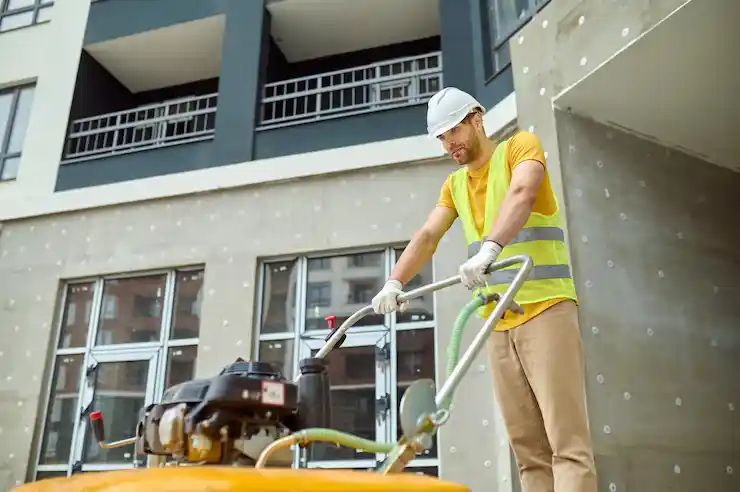Black mold is a fungus that thrives in moist, enclosed environments and grows. It is dangerous to health as inhalation of the spores can cause allergic reactions, coughing, or any other health problems.
Mold can be found in bathrooms, kitchens, basements, and almost everywhere. It can attach itself to walls, carpets, wood, and ceilings. Water leaks stagnant air and floods can worsen its viability.
Knowing how to get rid of black mold can prevent serious health problems and home damage. Removing black mold is important for your health and home. If you ignore it, mold can damage walls, floors, and furniture. Using the right cleaning methods will help keep your home safe.
How to Get Rid of Black Mold: A Complete Cleanup Blueprint
Learning how to get rid of black mold starts with identifying the affected areas, choosing the right mold-killing solution, and following a step-by-step cleaning routine—ventilate the space, apply your cleaner and let it sit, gently scrub away the mold, then dry and seal the surface to prevent any spores from coming back. Protective gear and moisture control are key to ensuring a safe, lasting mold-free environment.
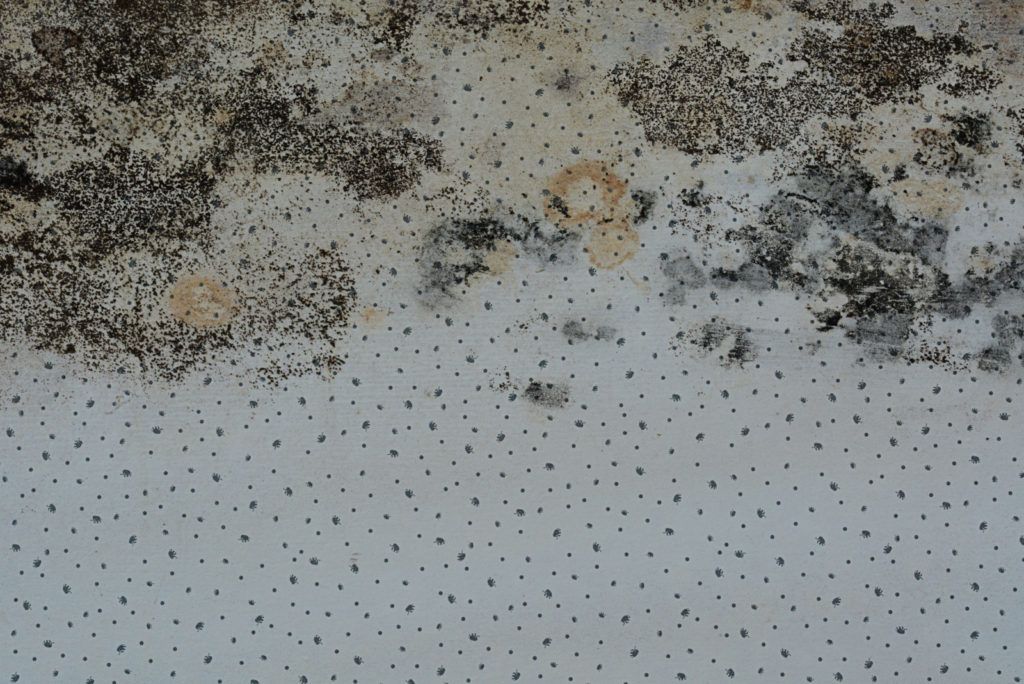
Choose the Correct Cleaning Product For Black Mold Removal
Safe and effective black mold clean up prevents long-term structural damage and health issues. To properly get rid of black mold cleaning, you need to have an effective black mold removal cleaning solution. Some products are superior to others, so one should always choose the safer, more potent one. You can choose from natural or chemical cleaners, each offering distinct advantages.
Let’s look at the most effective ways to remove black mold and consider whether hydrogen peroxide is a suitable choice.
What Solutions Kill Mold Best?
Getting rid of mold can be tough, so picking the right cleaner matters. If you’re wondering what kills mold, here’s a list of common mold-killing products.
- Hydrogen Peroxide: A natural germ killer that wipes out mold and germs.
- White Vinegar: A potent natural acid that helps wipe out mold and stops it from coming back.
- Baking Soda: A gentle but strong cleaner that soaks up moisture and keeps mold at bay.
- Bleach: A strong chemical that cleans surface mold but doesn’t kill deep-rooted spores.
- Store-Bought Mold Cleaners: Special mixtures made to target and wipe out mold.
Each of these choices has good and bad points, based on where the mold is and how much of it there is.
Black Mold Cleanup: Thorough Removal for a Healthier Home
Effective black mold removal cleanup goes beyond just wiping away surface spots—it’s about safely eliminating mold colonies at their source and preventing them from coming back. By choosing the right cleaning solution, scrubbing gently yet thoroughly, and drying every nook and cranny, you’ll not only remove existing mold but also create an environment where spores can’t regrow. Remember to wear protective gear, ventilate the area, and tackle any moisture issues to ensure your home stays mold-free long after the initial cleanup. Advanced black mold treatment includes antifungal application and long-lasting moisture control.
Natural vs. Chemical Cleaners
Both natural and chemical products can get rid of mold, but they work.
Natural Cleaners
Natural options like vinegar baking soda, and hydrogen peroxide are safe for homes, pets, and the planet. They don’t give off harmful fumes and are easy to find. But they might take more time to work on big mold patches.
Chemical Cleaners
Chemical options like bleach and store-bought mold removers work fast and kill mold on the spot. They’re strong but can hurt you if you breathe them in. Chemicals can also harm some surfaces so be careful when you use them.
Does Hydrogen Peroxide Kill Mold?
Absolutely! Hydrogen peroxide kills mold. It destroys the mold’s structure and gets rid of stains. Unlike bleach, it doesn’t produce harmful fumes.
Effective Mold Removal Using Hydrogen Peroxide
1. Put 3% hydrogen peroxide in a spray bottle.
2. Spray it right on the moldy area.
3. Wait 10–15 minutes to let it kill the mold.
4. Use a brush or sponge to scrub the area.
5. Use a clean cloth to wipe and allow it to dry.
Hydrogen peroxide works well on walls, tiles, and hard surfaces, but it might not be the best choice for fabrics or carpets.
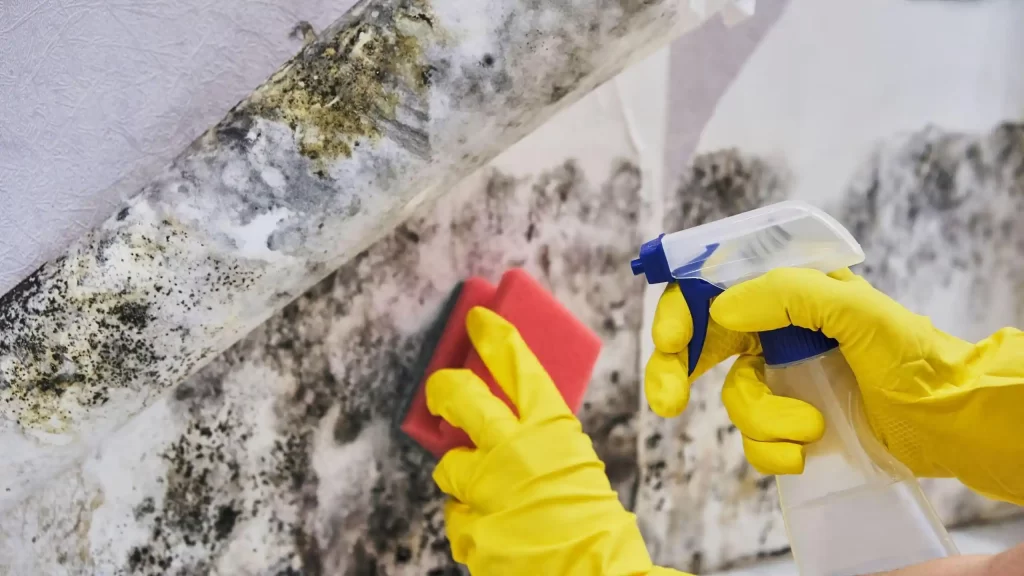
Which Solution Should You Choose?
The correct cleaner for use would depend on where and how extensive the mold is.
- Spot removal of mold: Vinegar or hydrogen peroxide works well.
- For large areas: Large areas that may need commercial cleaning agents or diluted bleach.
- Wooden surfaces: Use a milder cleaner like vinegar or baking soda to minimize possible damage.
- For carpets: a special mold-inhibiting carpet cleaner should be the answer.
Using the right solution will eliminate the mold safely and minimize future reseeding. Always use gloves, and remember to ventilate the area while you are cleaning.
Removing Mold from Walls
Mold on walls is a common problem, especially in damp areas like bathrooms, kitchens, and basements. If left untreated, it can spread and cause damage. Knowing how to clean mold off walls the right way will keep your home safe and healthy. Here’s how to do it properly. Thorough black mold cleanup stops the spread of spores and restores a healthy living environment.
Steps to Safely Clean Mold Off Walls
Before you start, make sure to wear gloves, a mask, and goggles to protect yourself from mold spores. Follow these steps to clean mold safely:
- Ventilate the Room: Open windows and doors to improve airflow. This helps stop mold spores from spreading in your home.
- Prepare Your Cleaning Solution: For effective black mold clean up, choose a mold-killing cleaner such as hydrogen peroxide, vinegar, baking soda, or a commercial mold remover.
- Test a Small Area: Before applying the cleaner to the entire wall, test it on a small spot to make sure it won’t damage the surface.
- Apply the Cleaner: Spray or wipe the cleaning solution directly onto the moldy area. Leave it for 10–15 minutes to loosen the mold.
- Scrub the Mold Away: Use a soft brush or sponge to gently scrub the mold off. For tough stains, a tougher scrub brush may be needed.
- Wipe and Dry the Surface: Use a clean cloth to remove any remaining mold and moisture. Ensure the area is fully dry to stop mold from coming back.
Best Cleaning Techniques for Different Wall Surfaces
Different wall materials require different cleaning methods. Using the right technique, especially for tasks like black mold removal, will help protect your walls from damage.
Painted Walls
- Use a mild cleaner like hydrogen peroxide or vinegar to avoid stripping the paint.
- Avoid scrubbing too hard, as it may remove paint.
- After cleaning, repaint with mold-resistant paint if needed.
Drywall (Unpainted or Porous Walls)
- Drywall absorbs moisture, making mold harder to remove.
- A mix of baking soda and water can help clean light mold growth.
- For deep mold, the affected drywall may need to be replaced.
Tile or Glossy Walls
- Mold on tiles is easier to remove because they are non-porous.
- Use hydrogen peroxide, vinegar, or bleach for deep cleaning.
- Scrub with a stiff brush to remove mold from grout lines.
Brick or Concrete Walls
- Mold can grow in the tiny holes of brick and concrete.
- A mix of vinegar and baking soda works well for scrubbing mold out of crevices.
- A wire brush can help remove stubborn mold from rough surfaces.
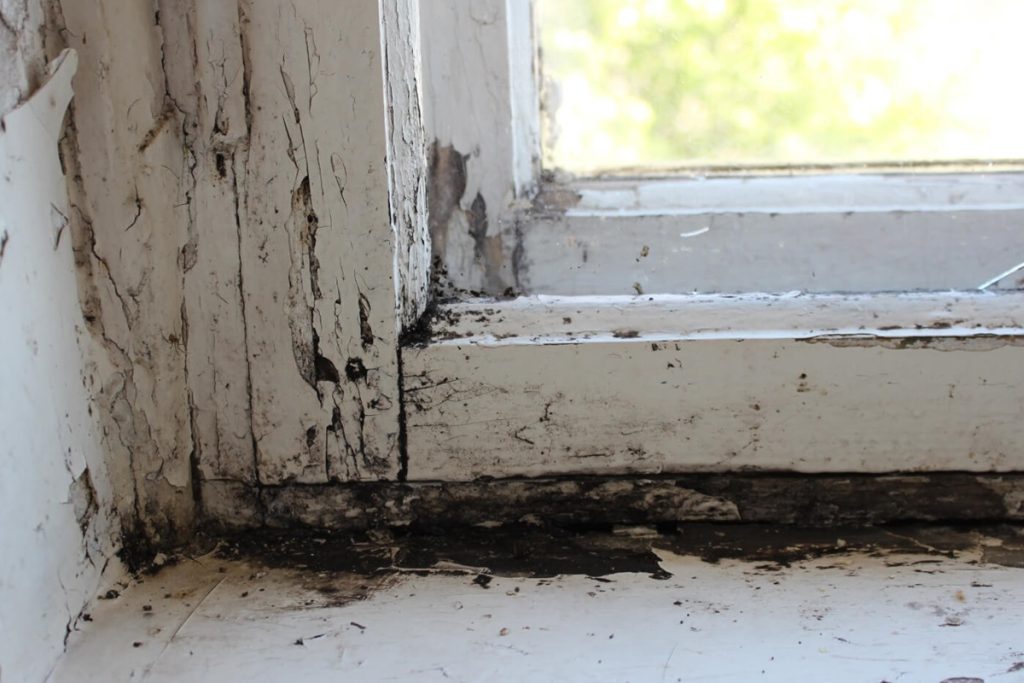
Preventing Mold from Returning in Damp Areas
Cleaning mold is only half the job. It’s important to fully remove black mold, not just clean its visible surface. However, to stop it from coming back, follow these prevention tips:
- Fix Leaks Quickly: Mold grows in damp conditions, so repair any leaky pipes or roofs right away.
- Reduce Moisture: Use dehumidifiers or exhaust fans in bathrooms and kitchens.
- Improve Ventilation: Open windows when cooking or showering to keep air moving.
- Use Mold-Resistant Paint: Special anti-mold paint can help prevent mold growth on walls.
- Keep Walls Dry: Wipe down walls in humid areas regularly to remove moisture.
By following these steps, you can remove mold from walls and prevent it from coming back. Regular cleaning and moisture control will keep your home mold-free and safe.
Removing Mold from Carpets
Carpet mold is a major problem. From mildewy places, it spreads rapidly and sometimes becomes impossible to remove. Unlike walls and hard surfaces, carpets retain moisture; hence, knowing how to get mold out of the carpet is important to stop mold spores from spreading easily.
Leaving moldy carpets unattended may let in bad smells, cause allergies, and eventually even damage your house. So knowing how to remove mold from carpet is very important in keeping your home healthy and fresh. Effective black mold removal solutions are formulated to kill mold and prevent it from returning.
Difficulties of Mold Remover in Carpets
Mold growth in carpets occurs due to excessive moisture, and the causes of moisture may include leaking water pipes, spills, flooding, or high humidity. Now, this is tricky because growth shows out not on the surface but hides deep down in the fibers.
It may also go on to the padding beneath when there is high spreading. Cleaning, therefore, becomes more difficult sometimes replacement may be the only option available.
How to Deep Clean Carpet Fiber Mold
For those who haven’t spread yet, the following is what you need to do to clean up the mold from your carpet safely.
Step 1: Dry the Area.
As we said before, mold loves moisture; therefore, drying the carpet first is highly imperative. Use fans, dehumidifiers, or even open windows to speed up the process. If you can, take the carpet outside and let it dry in the sun.
Step 2: Vacuum the Moldy Area.
Use a HEPA vacuum cleaner to suck any mold spores off the surface. Empty the vacuum outside to avoid it from spreading further inside.
Step 3: Apply a Mold-Killing Solution.
Choose one or another cleaner:
- White Vinegar – Kill all the mold and then inhibit it from coming back.
- Hydrogen peroxide – A natural disinfectant which works to removing mold and stains.
- Baking soda with water- This is for the absorption of moisture and deodorizing the carpet.
- Spray your selected solution on the affected area.
- Wait for ten to fifteen minutes to allow the solution to work on the mold.
Step 4: Scrub And Blot The Carpet
Gently scrub using a soft brush or cloth. Blot with a clean, dry towel to soak up extra moisture.
Step 5: Rinse and Dry Again
If necessary, rinse the area with clean water and blot dry. Set fans and sunlight to dry the carpet completely.
When to Replace a Moldy Carpet Rather than Cleaning It
At times, just cleaning will not help. Where mold has invaded the padding too deeply, even black mold removal cannot save it. Below are the scenarios when it is time to put your carpet to rest:
- Covers more than just a small section across your floor- it’s too large and will likely not be a success with cleaning.
- The carpet doesn’t even smell better after the mold is probably still underneath.
- People at home suffer from allergies or issues while breathing the presence of mold spores aggravates health problems.
- The carpet had been wet for more than 48 hours it had stayed moist for a long time, and likely, mold is already widespread.
- If any of these apply, it is safer just to replace the carpet than to risk health.
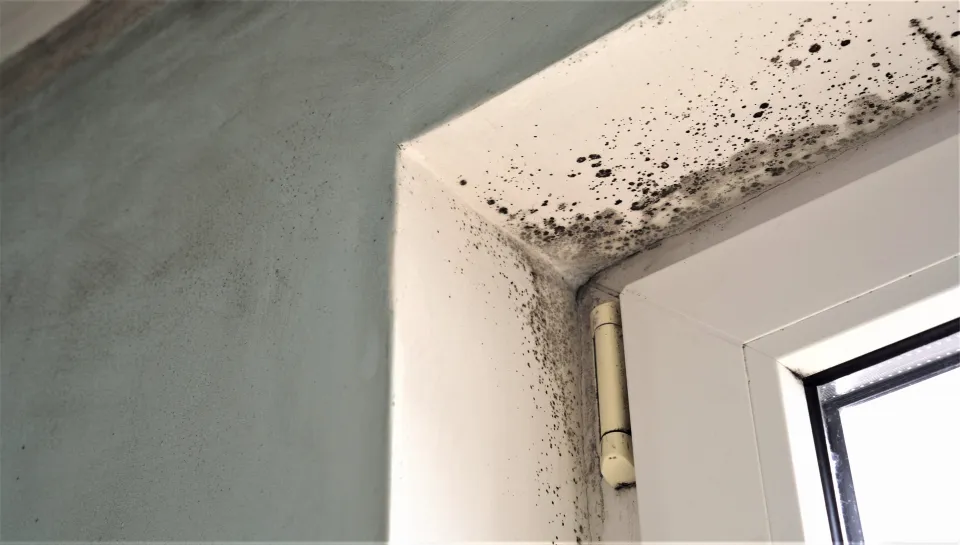
Last Minute Tips for Keeping Carpets Clear of Molds
- Keeping places well-ventilated will be to keep the rooms supplied with fresh air.
- Dehumidifiers would control moisture rations.
- Attend immediately to spills so that it will not stay wet on the carpets.
- Purchase mold-resistant carpets for areas prone to humidity.
- Learning how to get mold out of the carpet and when to dispose would keep your house fresh and free of mold.
- Cleaning and moisture control would be most effective against mold before it even grows at all!
Mold Removal Treatment for Wood
Wood is very susceptible to blood from the action of moisture. If mold is not removed from wood surfaces, then the question becomes how to kill mold on wood. The answer is simple! To disinfect wooden surfaces, first, dry the area very well and then take a soft brush and sweep off the loose mold.
Use a mold-killing substance such as white vinegar, hydrogen peroxide, or rubbing alcohol for in-depth cleaning. Let it sit for a few minutes and scrub it. After cleaning, leaving the wood completely dry prevents fresh mold growth.
To save future wood from mold, you can reduce indoor humidity; fix leaks; and apply sealant or mold-resistant coating. Hence, keeping wood surfaces dry is the best solution for preventing mold issues.
Again Using Alcohol and Other Treatments
“Does alcohol kill mold?” many people ask. Yes, but only as a surface treatment. Rubbing alcohol can kill mold spores- it just won’t penetrate deep into porous materials like wood. That makes it better suited for light mold infestations than stubborn or deep-seated mold.
Stronger treatment involves hydrogen peroxide or a commercial mold remover. These kinds of solutions kill mold better and prevent it from growing back. If it is too deep, sanding the wood may become inevitable to remove all traces.
Preventing the Return of Mold
The most efficient way to prevent recurring mold is to control moisture. Keep indoor areas dry by using dehumidifiers, exhaust fans, and proper ventilation. Repair leaks immediately even the tiniest amounts of moisture might encourage mold growth.
Regular cleaning is also necessary. Use a very mild vinegar solution to wipe down wooden surfaces to minimize the buildup of mold among spores. For damp places, consider utilizing mold-resistant paints or sealants. These coatings form a preventative barrier to discourage further mold growth.
These measures will help you become mold-free on your wooden surfaces and ensure proper black mold clean up to keep your home protected from further mold infestation problems.
How to Get Rid of Black Mold Safely and Effectively
Wondering how to remove black mold on your own? Start by ventilating the space and wearing protective gear. Clean small areas with mold-killing solutions, but avoid spreading spores. For extensive growth, always consult professionals who use containment barriers, HEPA filtration, and antimicrobial treatments to remove mold thoroughly and prevent future outbreaks.
Get Professional Black Mold Clean Up That Goes Beyond the Surface
Professional black mold removal is essential for protecting your home and health from toxic spores. Our black mold clean up service involves much more than surface cleaning. We assess the extent of the contamination, isolate the affected area, and remove mold-infested materials if needed. Using commercial-grade air scrubbers and fungicides, we ensure your home is safe, sanitized, and mold-free.
Conclusion
Getting rid of black mold is important for a safe and healthy home. Using the right cleaning methods and preventing moisture buildup will help keep mold from coming back. The right cleanup methods can effectively kill the mold and stop it from coming back. You must maintain it over time by bringing in proper ventilation and using mold-resistant materials.
FAQS
Q: What’s the safest and most effective method on how to remove black mold?
A: To safely tackle how to remove black mold, start by wearing protective gear (gloves, goggles, and an N95 mask) and ventilating the area. Spray the affected surface with a mold-killing solution—white vinegar or 3% hydrogen peroxide—let it sit for 10–15 minutes, then scrub gently with a brush. Wipe away any residue and use fans or a dehumidifier to dry thoroughly, preventing mold spores from returnin



